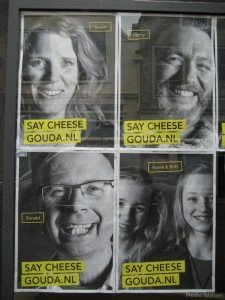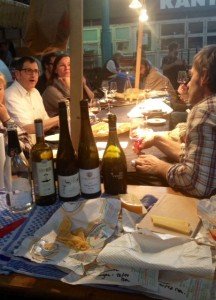You say Gouda, I say Chowda… Is there a cheese that is more misunderstood than this Dutch fellow? For some it’s the ultimate, mass-produced boredom of cheese, reduced to a marginal existence on breakfast buffets and sandwiches, for others it means a sophisticated, aged farmer’s wheel full of concentrated, caramelly goodness. The truth, as usual, lies in both as well as in between. We explored it.
 A few years ago, I had ventured on an extensive research trip to Gouda land, and come back truly impressed: by this small country where not a single acre seems to be left unused, by its beauty, by its liveliness – and by its cheeses and the people I met through them. Here is the report of my trip to Gouda shores in Effilee. But I also wanted to share it all with you in taste and smell, during this HeinzelCheeseTalk. So we met at the usual place, the large table in Markthalle Neun opposite the Suff wine stall, and went Dutch. First of all: I was a little surprised how much interest you showed; I could have filled the table twice, even three times… I had not gone back to the Netherlands to procure the cheesy goods, but had most of them sent to me courtesy of the online shop Goudse Kaas Shop. It seemed a little absurd to do this from the very centre of Berlin with no shortage of places to buy Gouda of all kinds – but obviously not everybody is as fortunate and I’m interested in what your options are if living a little more remote.
A few years ago, I had ventured on an extensive research trip to Gouda land, and come back truly impressed: by this small country where not a single acre seems to be left unused, by its beauty, by its liveliness – and by its cheeses and the people I met through them. Here is the report of my trip to Gouda shores in Effilee. But I also wanted to share it all with you in taste and smell, during this HeinzelCheeseTalk. So we met at the usual place, the large table in Markthalle Neun opposite the Suff wine stall, and went Dutch. First of all: I was a little surprised how much interest you showed; I could have filled the table twice, even three times… I had not gone back to the Netherlands to procure the cheesy goods, but had most of them sent to me courtesy of the online shop Goudse Kaas Shop. It seemed a little absurd to do this from the very centre of Berlin with no shortage of places to buy Gouda of all kinds – but obviously not everybody is as fortunate and I’m interested in what your options are if living a little more remote.

I also wanted to check with your help how „normal“ the regular stuff from pasteurized milk and produced on a large scale really is. Let’s say, you didn’t exactly fall off your chairs in awe and wonder… but it’s edible if boring. The lack of milky concentration is replaced by (natural) coloring with annato, and for some reasons the label mentioned vitamins A, B, and D – why is still a mystery to me. 2, 4 and 10 months, well, well. Then, the real stuff, Boerenkaas, which is farmstead cheese, made from raw milk, at 10 and 14 months, and then over 3 years old – a completely different story, the last one crumbly and caramelly. Also very good: the semi-aged (which in that case meant 10 to 12 months – all those age designations are very fluid) from Maître Philippe – who had also provided us with an aged, real, raw milk Edam. More yellow fruit and fresh cut straw than caramel, and for me one of the most underestimated cheeses of our times.

We finished with Jan Dirk van de Voort’s Remeker (9 months, in Berlin available at Knippenbergs). Biodynamic, from Jersey cows‘ rich raw milk, this is Gouda 2.0, perhaps even 3.0… You can read more about it here – and Jan Dirk will be at the Cheese Berlin on November 1st. Winewise we followed in the old Dutch merchants‘ footsteps and went all over the place, from pink Cava (thanks Wernher!), to Greek Assyrtiko from Santorini (thank you Ben!), a beautifully aged Frühlingsplätzchen Riesling from the Nahe’s brilliant Emrich-Schönleber estate to a great Austrian Grüner Veltliner from Peter Veyder-Malberg (2013 Liebedich, and our favorite with the cheese!) to a surprising finale of „black“ bubbles, a delicious Lambrusco from Suff. It was a vast subject, and we only covered a tiny bit of it, but it was a joy to do this with you – as usual! Cheesio to everybody.
HeinzelCheeseTalks take place regularly, usually on a Friday at 6pm at Markthalle Neun in Berlin-Kreuzberg. I bring some interesting cheese, open a few bottles of wine, and we sit around the large table opposite the Suff wine stall, tasting, drinking, talking, discussing (mostly in German – but we usually manage to cater to English speakers too). Invites are sent out about ten days before we meet, to a mailing list you can join here. Reservations need to be confirmed and are strictly by first come first serve – so be quick! And please do let me know if you can’t make it – there is always a waiting list. A donation of ten euros per person (or one or two euros more if you really had a lot of fun…) is much appreciated. Cheesio!
